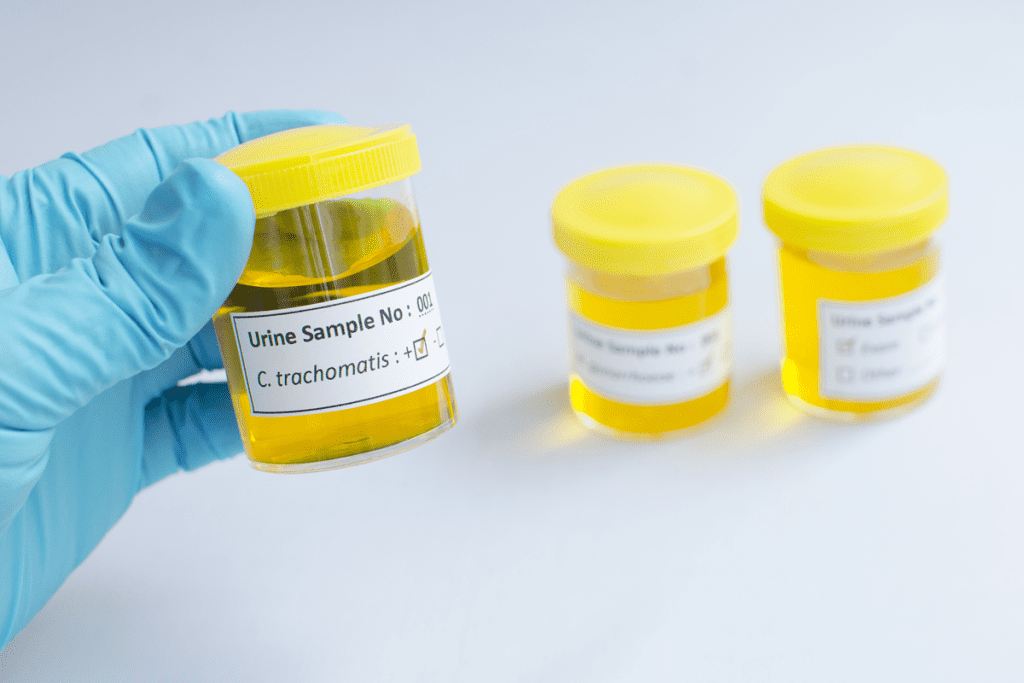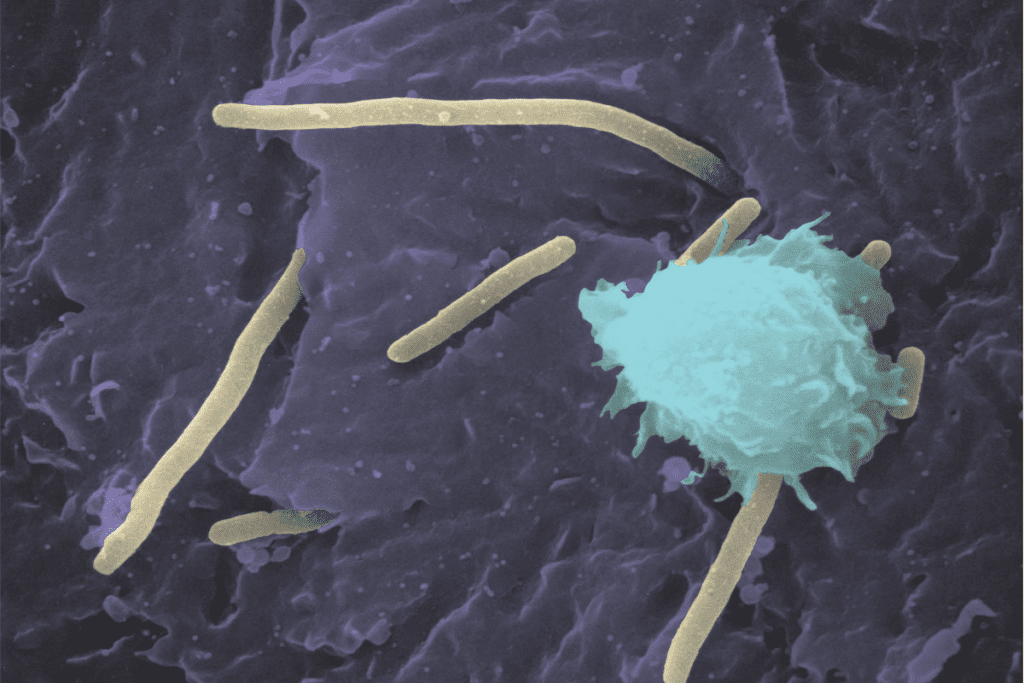Last Updated on November 25, 2025 by
How many bacteria in urine is normal? Understand what a UTI test looks for. This crucial guide details the powerful difference between normal flora and infection.
It’s important to know how many bacteria in urine are normal. This helps doctors figure out if you have a urinary tract infection. Usually, urine doesn’t have many bacteria. But, some bacteria levels are okay, depending on different things.

A urinalysis test shows if there are bacteria in your urine. It also helps understand what it means. Liv Hospital says it’s key to use exact lab tests and follow proven ways to handle bacteria in urine.
Knowing what UTI means and understanding urinalysis results is very important. It helps doctors diagnose and treat you right.
Bacteria in urine can signal health problems. Knowing what’s normal is key to understanding test results and spotting issues like urinary tract infections (UTIs).
Once, urine was thought to be clean in healthy people. But new studies say our urinary tract might have its own set of microbes.
The usual cut-off for too many bacteria is 100,000 colony-forming units per milliliter (CFU/mL). Counts under this are usually okay, but it depends on symptoms and more.
New research has changed how we see the urinary microbiome. It shows a complex world in our urine that’s vital for our health. Even healthy folks can have bacteria in their urine, shaking off the idea of sterile urine.
Let’s look at how we measure bacteria in urine. Test results, like white blood cells (WBCs), help spot UTIs. WBCs in urine can mean an infection or inflammation. For example, a sample from a bladder infection might show more WBCs.

Understanding normal bacteria levels and the urinary microbiome helps doctors read test results better. They can then diagnose UTIs more accurately. It’s important to look at both bacterial counts and other signs like WBCs in urinalysis.
It’s important to know how bacteria in urine are measured to diagnose urinary tract infections (UTIs). Bacteria in urine, known as bacteriuria, can show an infection. But, the amount and type of bacteria are key to knowing how serious it is.
Bacteria in urine are measured in colony-forming units per milliliter (CFU/mL). This number shows how many live bacteria can grow on a culture medium. A higher CFU/mL count usually means a bigger infection.
For example, counts between 1,000 and 100,000 CFU/mL might show a UTI in people with symptoms. Here’s what CFU/mL counts mean:
There are two ways to find bacteria in urine: urinalysis and urine culture. Urinalysis checks a urine sample for things like nitrites and white blood cells (WBCs). A nitrite-positive urine test means certain bacteria are present.
Urine culture grows bacteria in a lab. It gives a precise count of bacteria (CFU/mL) and helps find the bacterial type causing the infection.

Understanding UTI test results is key. Look at markers like high WBC in urine and nitrite presence. A high WBC count means there might be an infection or inflammation in the urinary tract.
When looking at test results, remember:
Knowing what nitrite in urine means is important. It helps diagnose infections caused by certain bacteria. But a full diagnosis looks at symptoms and other urinalysis markers too.
Understanding when bacterial counts in urine show a health issue is key to diagnosing UTIs. Tests like urine analysis (UA) and urine culture are crucial. They help detect bacteria and diagnose UTIs.
The bacterial count in urine is a major factor in diagnosing UTIs. It’s measured in Colony-Forming Units per milliliter (CFU/mL). Knowing the importance of these counts is vital for accurate diagnosis and treatment.
A count of 100,000 CFU/mL or higher is traditionally used to diagnose UTIs. This number is based on studies showing it’s likely a true infection. But, symptoms and other urinalysis results also play a role in diagnosis.
For example, a patient with UTI symptoms might be treated even with a count below 100,000 CFU/mL. Testing for bacterial counts involves a urine culture. This can take 24 to 48 hours for results, depending on the lab and testing methods.
In patients with symptoms, even lower counts can be significant. Some studies suggest counts as low as 1,000 CFU/mL can indicate infection. Treatment decisions are based on symptoms, urinalysis results, and the patient’s health.
To test for UTI, healthcare providers start with a urinalysis. This test can show bacteria, blood, or other abnormalities. If it suggests infection, a urine culture may follow to identify bacteria and choose the right antibiotic.
Other markers in urine can also show infection. These include leukocyte esterase, nitrites, and blood. These markers, along with bacterial counts, help diagnose UTIs more accurately.
It’s important to note that asymptomatic bacteriuria is not treated unless in specific cases, such as in pregnant women. Treatment decisions are based on a full assessment of the patient’s condition.
Getting a correct diagnosis of urinary tract infections depends on knowing what affects bacterial counts in urine. Different things can change these counts. It’s important to think about these factors for a precise diagnosis.
The way urine samples are collected is key to determining bacterial counts. Contamination during sample collection can make results look worse than they are. To avoid this, it’s crucial to use the right collection method, like a clean-catch midstream urine sample.
Even with proper testing, contamination can still happen if the sample isn’t handled right. Knowing about this risk is key to understanding test results correctly.
Asymptomatic bacteriuria is when bacteria are in the urine, but there are no symptoms of infection. This is more common in some groups, like the elderly or those with catheters. Even with high bacterial counts, it doesn’t always mean you need treatment.
Telling the difference between asymptomatic bacteriuria and a real infection is important. It helps avoid overusing antibiotics and makes sure patients get the right care.
Some groups face more risks from urinary tract infections or have different standards for what’s normal. For example, pregnant women, people with diabetes, and those with weakened immune systems need extra care.
Healthcare providers need to understand these special needs to manage urinary tract infections well in at-risk groups.
Knowing about bacteria in urine is key to spotting and treating urinary tract infections (UTIs). It’s important to understand urinalysis results and UTI tests to find bacteriuria.
Liv Hospital stresses the need for accurate lab tests and evidence-based care for bacteriuria. This helps doctors give the right treatment. It lowers the chance of problems and improves health.
To understand urine bacteria levels, doctors look at symptoms, medical history, and lab results. A detailed approach helps make better care decisions. This leads to better health for patients.
Urine is usually sterile, meaning it has little to no bacteria. But some bacteria levels can be normal, depending on different factors.
The threshold for significant bacteriuria is 100,000 colony-forming units per milliliter (CFU/mL).
Yes, counts between 1,000 and 100,000 CFU/mL might show a UTI in patients with symptoms.
Urinalysis checks for various urine components, like bacteria and white blood cells. A urine culture specifically identifies bacterial types and amounts.
A positive nitrite test suggests certain bacteria are present. This could mean a UTI is possible.
High white blood cells (WBCs) in urine may show an infection or inflammation in the urinary tract.
Urine culture results take a few days. This is because bacteria need time to grow in the culture medium.
Asymptomatic bacteriuria means having significant bacteria without UTI symptoms. It usually doesn’t need treatment, except for pregnant women.
Contamination can lead to false-positive results. This shows higher bacterial counts than are actually there.
Yes, pregnant women, older adults, and those with weak immune systems need special attention. This is when looking at urine bacteria levels and treatment decisions.
Subscribe to our e-newsletter to stay informed about the latest innovations in the world of health and exclusive offers!